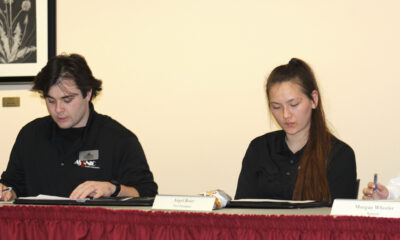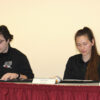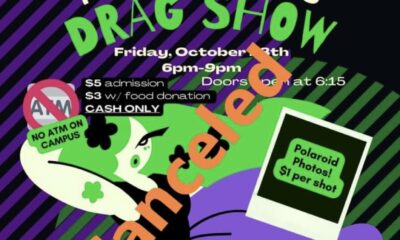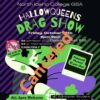NIC hosts events to raise awareness, educate students, community
The room fell silent as people lit their candles. Lights were dimmed, and the only noise was the soft music in the background. Some people cried; most seemed to look within themselves. All held their candles.
Across the state, hundreds of Idahoans lit candles at the exact same moment in a mass demonstration of support for all those affected by HIV and AIDS.
Around 20 to 25 community members and students alike gathered Thursday evening to attend a candlelight vigil held in the Human Rights Education Institute in observance of World AIDS Day. The North Idaho AIDS Coalition (NIAC) organizes the event annually. Refreshments, cookies and a bowl full of candy and condoms were offered to all those in attendance.
“There’s a huge community, which I never knew about, that will support you,” said Mat Dexter, massage therapy, Athol, and Gay-Straight Alliance (GSA) member.
The vigil began with the viewing of a video that told the stories of people infected with HIV or AIDS. Stacie Lechot, executive director of NIAC, introduced speaker Darrell Pero, a local 23-year-old dealing with HIV. His story seemed to captivate the crowd. He spoke of the fear and depression he felt when he was diagnosed.
“I hated the very fiber that created the human race,” Pero said. His words reached a solemn audience. He addressed the commonly accepted belief that people with AIDS live lonely lives and strongly asserted that this is not true; everybody can find love no matter what their condition. He spoke about how it is now possible to live with HIV/AIDS.
“I’ve lost some friends to AIDS. I’m old enough to remember a world without AIDS,” said Mark Haberman, Minn. “It was nowhere 30-plus years ago,” he said. He said has worked for the last several years with a church-sponsored retreat for HIV-positive individuals.
After Pero’s speech, a film was played featuring Ryan White, a boy from Kokomo, Ind. White was a hemophiliac since birth and diagnosed with AIDS at age 13. Doctors gave him three to six months to live. He was expelled from his high school for his condition. His mother fought for his right to an education, gaining national publicity and support. Eventually his condition improved enough for him to go back to high school and even got a job. He died at 18 in 1990. Congress passed the Ryan White CARE (Comprehensive AIDS Resources Emergency) Act a few months after his death to help poverty-level people get help and pay for medicine.
Doug Edwards, Coeur d’Alene, attended the event to support Pero.
“There are too many people who are not aware how wide-spread and how close HIV and AIDS are to them,” Edwards said. He said that events like these are very important for the people of our community to be exposed to.
“It brings it closer to home, and it needs to,” Edwards said.
According to www.AIDS.gov, more than one million people in the United States are infected with AIDS. Every nine and a half minutes, someone in the USA is infected. Nearly 33.4 million people in the world have AIDS.
“The whole [state of] Idaho has about 1,200-1,250 people,” Lechot said.
ASNIC organized an event in the SUB Thursday afternoon, which included information, giveaways and speaker Christina Cowden, who shared her personal experiences with HIV/AIDS. National and world statistics were also given.
World AIDS Day is held Dec. 1 every year and is a time for people to unite in the fight against HIV and honor those who have passed. World AIDS Day was the first official global health day. It was first held worldwide in 1988. According to www.worldaidsday.org, more than 25 million people died from the virus between 1981 and 2007. World AIDS Day events around the world are intended to help educate as many people as possible about HIV/AIDS and how it is spread.
Lechot stressed the importance of getting tested. She said in most cases, symptoms wouldn’t become visible for up to 10 years unless the person is drinking heavily or using drugs.
“You can be healthy and you don’t feel it, but it doesn’t hide. So if you get a test you’ll know,” she said.
Lechot said AIDS spreads so quickly simply because a lot of people who have it don’t know they have it and end up passing it along by accident.
NIAC covers the five northern-most counties in Idaho. The organization helps AIDS-infected, poverty-level people acquire funds from programs like Ryan White’s CARE. In some cases, NIAC can help with housing and living costs. NIAC conducts free HIV/AIDS screenings.
“To have people be able to wear the red ribbon and come tonight really makes my heart warm because my clients think they’re alone,” Lechot said.











